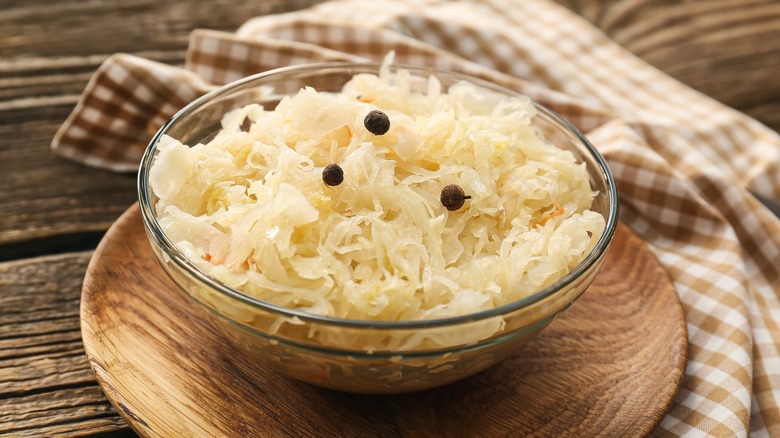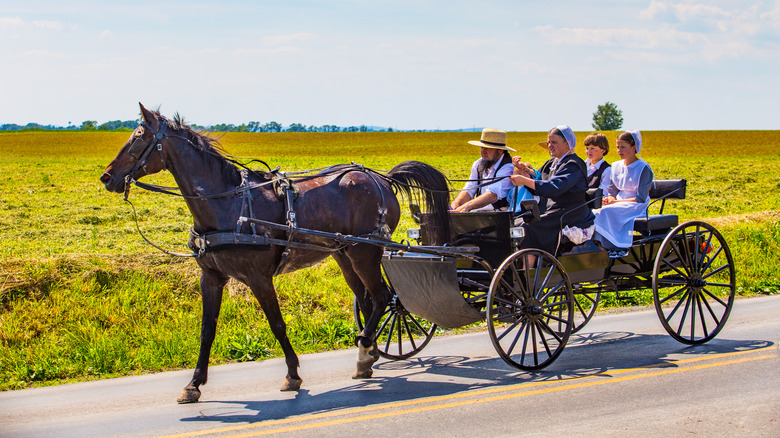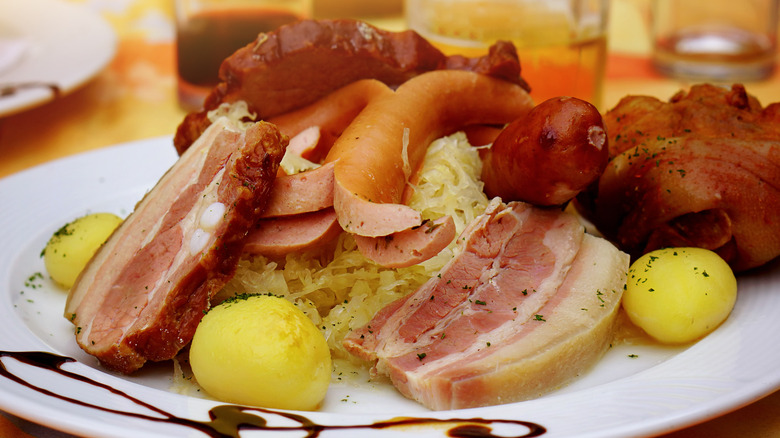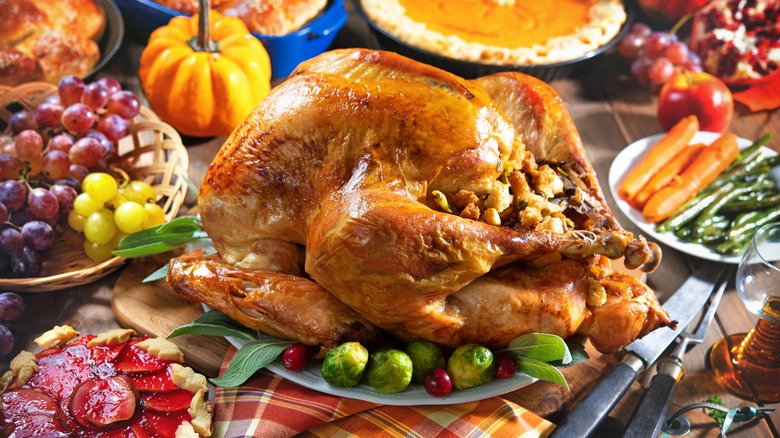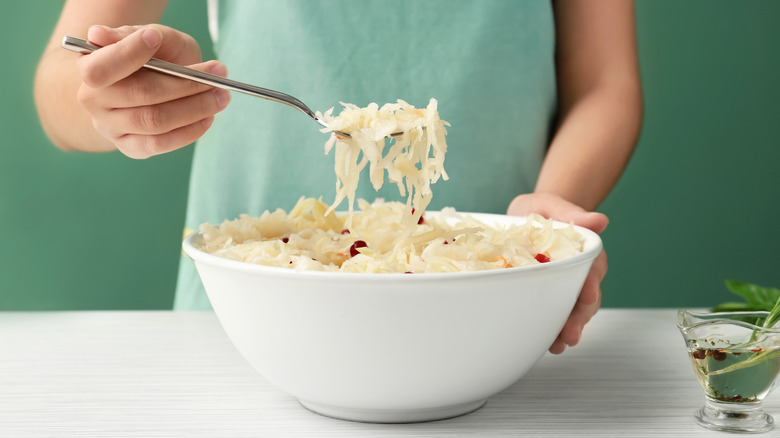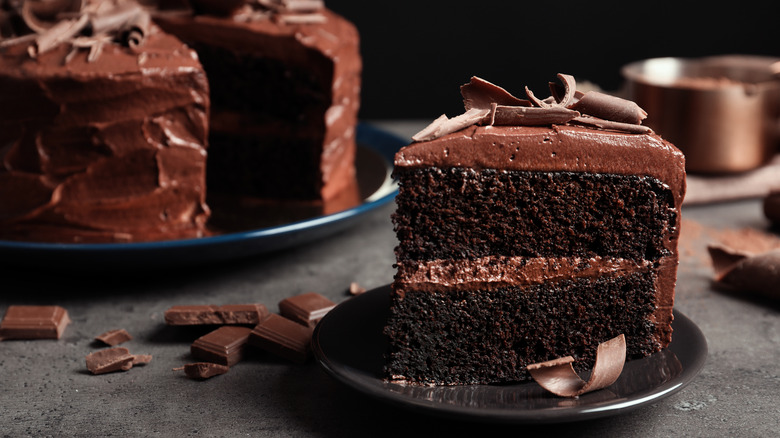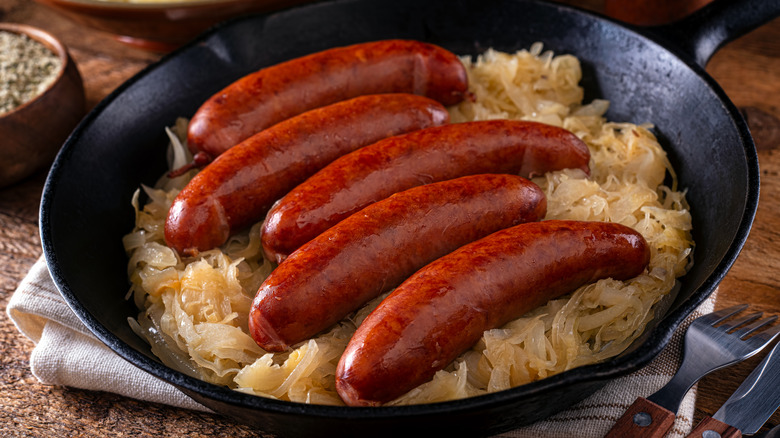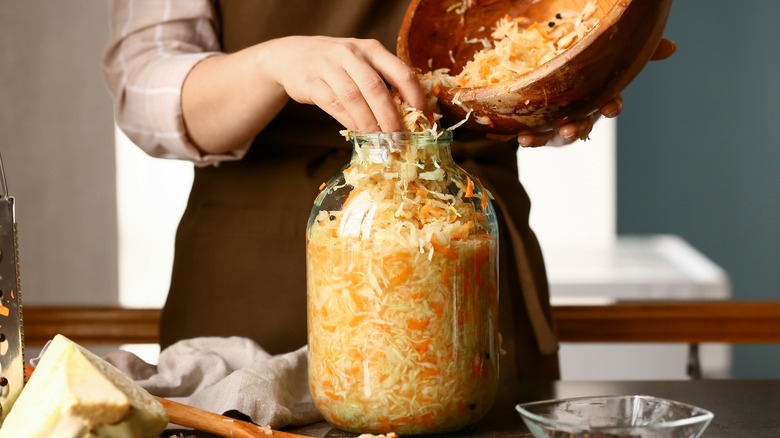The Untold Truth Of Sauerkraut
Sauerkraut is not a subtle food. It smacks you over the head with acidity and salt, and its smell has been known to clear a room. But if you can withstand its onslaught of sour fermented flavors, it will reward you. It's a delicious pairing with any kind of fatty meat, cutting through the richness like a knife through butter. It can also keep your body running in peak condition, thanks to an incredible array of health benefits. Sauerkraut may be an acquired taste for some, but we think it's a taste worth acquiring.
The history of sauerkraut is just as intriguing as its flavor. This unassuming preserved cabbage has traveled the globe from Asia to America, graced Thanksgiving tables, and even shown up as a secret ingredient in chocolate cake (yes, really). Love it or hate it, you have to at least respect kraut's longevity and versatility. Join us as we trace sauerkraut's journey and see how it turned into the food we (or some of us, anyway) enjoy today.
Sauerkraut is from China
We all know where sauerkraut is from, right? It's as German as beer steins, lederhosen, sausages, and pretzels. It's true that Germans eat sauerkraut and that the name for this fermented cabbage comes from German, but shockingly, according to The New York Times, sauerkraut's true origins lie further East.
Fermented cabbage was actually invented as a way to feed laborers who worked on the Great Wall of China. The rations for workers consisted of rice and cabbage. In order to preserve the cabbage over the winter, an ingenious cook decided to pour some rice wine into the vegetable, which made it ferment. Per The Baltimore Sun, this method for fermenting cabbage arrived in Europe with Genghis Khan around 1,000 A.D. The NY Times says that the Tartars may have also had a hand in bringing sauerkraut to Europe. At some point during this time, the rice wine got swapped out for salt, and modern sauerkraut was born.
Although sauerkraut is no longer typically associated with China, Asian cultures still preserve leafy vegetables today. Korean kimchi and Chinese pickled mustard greens are two good examples.
It could also possibly be from Rome
While the sauerkraut that ended up in Germany may be of Chinese origin, preserved cabbage was already being made in Europe long before the Mongols brought it over from Asia. According to The Baltimore Sun, Roman writings from 200 B.C. mention using salt to preserve cabbage, which sounds a whole lot like sauerkraut to us.
Per historian Cato the Elder, the ancient Romans were wild about cabbage. They grew three main varieties, including a leafy kind reminiscent of modern kale and a round one more akin to what we call cabbage today. Ancient Roman physicians loved cabbage for its positive health effects. Romans commonly pickled it, producing a sour salty product with a similar taste as sauerkraut, though slightly different. To make this type of pickled cabbage, ancient cooks would blanch the vegetable and then submerge it in a mixture of salt and vinegar.
Sauerkraut helped sailors stave off scurvy
Scurvy, a disease caused by a lack of vitamin C, was historically the leading cause of death for sailors (via Hektoen International). It killed more seamen than all other causes of death combined, including disease, violence, and shipwreck. The problem was that vitamin C is mostly found in fresh fruits and vegetables, which were hard to come by on long sea voyages.
The person credited with figuring out how to prevent scurvy (or at least fatal cases of it) among mariners in the 18th century was Captain James Cook. He brought several kinds of foods on his ship the Endeavor, to see which ones would guard against the illness. Vitamin C wasn't discovered until the 20th century, so Cook didn't know the root cause of scurvy, but nevertheless, he was able to figure out which foods kept his men healthy. He found that citrus and sauerkraut, which are both rich in vitamin C, totally eliminated fatal cases of scurvy from his voyages.
The Pennsylvania Dutch brought sauerkraut to America
So we know how sauerkraut ended up in Europe, but how did it cross the pond to American shores? According to What's Cooking America, sauerkraut has a long history in the US, and the first written record of its existence stateside dates from 1776. We have the Pennsylvania Dutch (who are, confusingly, not Dutch but German) to thank for bringing sauerkraut to America.
William Penn, the founder of Pennsylvania, should get some of the credit as well. He established Pennsylvania as a haven of religious tolerance, which encouraged German-speaking immigrants from religious groups like the Mennonites, Amish, and Brethren to escape religious persecution in their homelands and settle in the new colony in large numbers. These immigrants brought sauerkraut with them to their new home, and they didn't just bring the recipe. They actually packed barrels of sauerkraut from the old country on the ships they sailed to America because of its previously mentioned scurvy-fighting properties.
The French made sauerkraut fancy
As we have already established, despite its reputation as stereotypical German food, sauerkraut is quite popular outside of Germany as well. Per Serious Eats, another place with a long and proud history of sauerkraut consumption is France, specifically Alsace, an area on the border with Germany (which at some points in history has actually been ruled by Germany). In France, they call it choucroute, and Alsatian choucroute garnie is the glitziest, most luxurious possible version of humble sauerkraut.
Choucroute garnie might as well be called "one million meats garnished with a little sauerkraut." It's a pork-lovers dream, loaded with pork loin, pork shoulder, ham hock, sausages, bacon, and salt pork. It also traditionally includes onions sauteed in goose fat, just in case that wasn't enough meat for you. The whole mess is cooked in white wine and seasoned with juniper berries, creating a complex hearty stew that will warm you on even the chilliest winter days.
It's a Thanksgiving staple in Baltimore
Every region of America adds its own spin to Thanksgiving dinner (via FiveThirtyEight). The Midwest shows extra love for casseroles, while the South considers mac & cheese to be obligatory. New England loves its squash, and Texas and Louisiana need cornbread on the table. Of course, no one would be surprised to see a casserole at Thanksgiving dinner on the East Coast or mac & cheese and turkey in California. The same can't be said for Baltimore's preferred Thanksgiving side: sauerkraut.
Per The Baltimore Sun, Charm City's love of turkey and sauerkraut comes from its German heritage. When Abraham Lincoln made Thanksgiving an official holiday, a quarter of the city's population were German immigrants. Thanksgiving sauerkraut may have descended from a Pennsylvania Dutch recipe for roasting a whole bird stuffed with kraut, or it might have just been a way for Baltimore's European immigrants to add a touch of their homelands to a new American tradition.
Even in Baltimore, not everyone loves Thanksgiving kraut; one resident told The Sun that "I've never been a fan of kraut. I think it smells like feet. I also think it ruins the delicious smell of turkey." However, we think sauerkraut would be a great addition to the Thanksgiving table. So many of the holiday's traditional foods are starchy, savory, and fatty, and a little acidity to wake up the palate sounds like a good idea to us.
Sauerkraut is super good for you
We already covered that sauerkraut can save you from scurvy, but that's just the beginning of fermented cabbage's health benefits. According to WebMD, sauerkraut is packed with vitamin C, vitamin K, potassium, iron, folate, manganese, and copper, plus it's also a good source of fiber. In addition to those nutrients, the fact that sauerkraut is a fermented food makes it great for your gut health. It's chock-full of probiotics, which can help your body's digestive system run smoothly and may have other benefits as well.
WebMD says that probiotics may also help you lose weight because they could reduce the amount of fat your body absorbs from food, although research on this topic is still in the early stages. Sauerkraut's high fiber content and low-calorie count might contribute to weight loss as well, as the fiber makes you feel full and can reduce your desire to overeat. Regardless of whether you're looking to manage your weight or not, sauerkraut is such a nutritional powerhouse that it's a great addition to anyone's diet.
It's supermodel fuel
The French aren't the only ones adding some glamor to humble fermented cabbage. Apparently, sauerkraut is one of the favorite foods of a couple of different supermodels. Heidi Klum grew up around Cologne, Germany, and she loves to cook sauerkraut soup. She even made it for the judges on "America's Got Talent" (via Yahoo! News). While we're sure they appreciated the gesture, apparently the flavor of this traditional German specialty didn't win approval from Howie Mandel or Simon Cowell. Klum herself said, "it does look like someone ate something and threw it back up."
If that doesn't scare you off, you can always try making it yourself using the recipe she shared with Rachael Ray. According to The Spruce Eats, Klum credits her figure to her grandmother's sauerkraut soup, so it must be doing something good for her. She's not the only one on board, and Russian supermodel Ana Azarova is also a fan of sauerkraut.
You can use sauerkraut in desserts
Sauerkraut is sour, salty, savory, and funky. It tastes great with pork, on a hot dog, or (if you believe Baltimoreans) with turkey. Have you ever wondered if it would taste good in dessert? Apparently, some people have because you can find several recipes for kraut desserts floating around the internet.
Frank's Kraut has several different recipes for kraut cakes on its website. In case you think this is just an instance of a food manufacturer throwing its product into recipes it has no business being in (we're looking at you, Vegemite icy poles), we found other instances of people singing the praises of sauerkraut chocolate cake. A cook on Just a Pinch posted a recipe for the treat that she transcribed from her mother-in-law's Indiana Church Cookbook from 1950, so it seems like sauerkraut cake has real fans out there. One food blogger insisted that every person who ate her sauerkraut chocolate cake loved it and that the recipe produced a uniquely moist, fudgy confection (via An Affair from the Heart).
We also found a recipe for sauerkraut candy on Food.com that looks like a basic marshmallow fudge recipe with rinsed kraut added to the mix. If you're brave enough to try this, we'd love to hear from you.
Sauerkraut is supposed to bring luck on New Year's Day
In addition to kraut's healthy nutritional profile, it might also help you ring in the new year with good fortune. As Reader's Digest explains, a meal of sauerkraut and pork on New Year's Day is traditionally believed to give you good luck and prosperity. This New Year's meal is grounded in German and Eastern European food traditions.
Food historian Linda Pelaccio tells Reader's Digest that cabbage's round shape is auspicious because coins are round. Also, since cabbage is green, it symbolizes money and wealth. European cultures would have historically eaten sauerkraut instead of fresh cabbage on New Year's because fresh veggies weren't available in January. The pork component of the meal is just as symbolic. Pelaccio says that pigs move forward when they're looking for food, which is a metaphor for moving ahead in the new year. Pork is also fatty, and fat is yet another symbol of wealth.
It's easy to make at home
Although you can find canned sauerkraut in any grocery store, it often doesn't taste great. Canned kraut can be overly acidic and the cabbage pieces have a tendency to be mushy. If you think you're not a fan of sauerkraut because you've only had the canned stuff, freshly made kraut might change your mind. It's a totally different beast, with a pleasant crunch and a flavor that balances sourness with sweetness and fermented funk.
Our recipe for homemade sauerkraut is so easy and delicious that you'll never want to buy the premade stuff again. It has only five ingredients and it comes together really quickly. Once you're finished eating the cabbage, don't throw out the liquid; leftover sauerkraut juice is a very versatile ingredient for cooking at home. You can add it to Bloody Marys, use it as a meat marinade, or even just drink a few sips to settle your stomach before a particularly indulgent meal.
Sauerkraut might soothe your hangover
Sauerkraut is so healthy that it might even help rescue you after a night spent poisoning yourself with liquor. Women's Health recommends sauerkraut as the perfect day-after food to kill your hangover and recover from last night's booze. Of course, no food can magically cure a hangover all by itself, but sauerkraut has some attributes that might ease your pain a little bit.
For one, you lose vitamins when you drink, so sauerkraut can help you replace some of the nutrients the alcohol has kicked out of your system. Furthermore, the probiotics in kraut might settle your upset stomach, and they can also help you burn all the calories you drank. Also, alcohol is a toxin, and sauerkraut is filled with antioxidants that can help counter booze's negative health impacts. Maybe the next time you hit the sauce a little too hard, you should reach for a nice healthy plate of choucroute garnie instead of a greasy diner breakfast.
